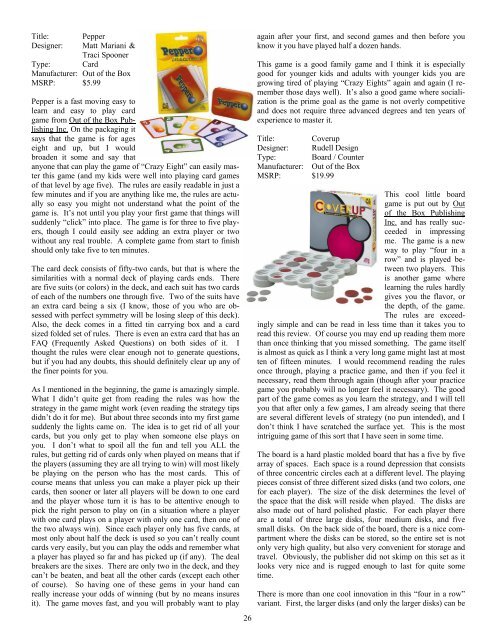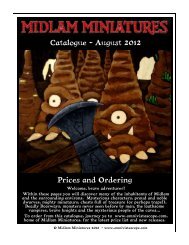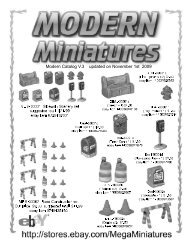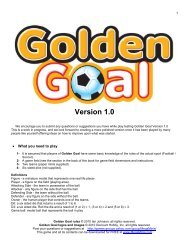Download - Mega Miniatures
Download - Mega Miniatures
Download - Mega Miniatures
You also want an ePaper? Increase the reach of your titles
YUMPU automatically turns print PDFs into web optimized ePapers that Google loves.
Title: Pepper<br />
Designer: Matt Mariani &<br />
Traci Spooner<br />
Type: Card<br />
Manufacturer: Out of the Box<br />
MSRP: $5.99<br />
Pepper is a fast moving easy to<br />
learn and easy to play card<br />
game from Out of the Box Publishing<br />
Inc. On the packaging it<br />
says that the game is for ages<br />
eight and up, but I would<br />
broaden it some and say that<br />
anyone that can play the game of “Crazy Eight” can easily master<br />
this game (and my kids were well into playing card games<br />
of that level by age five). The rules are easily readable in just a<br />
few minutes and if you are anything like me, the rules are actually<br />
so easy you might not understand what the point of the<br />
game is. It’s not until you play your first game that things will<br />
suddenly “click” into place. The game is for three to five players,<br />
though I could easily see adding an extra player or two<br />
without any real trouble. A complete game from start to finish<br />
should only take five to ten minutes.<br />
The card deck consists of fifty-two cards, but that is where the<br />
similarities with a normal deck of playing cards ends. There<br />
are five suits (or colors) in the deck, and each suit has two cards<br />
of each of the numbers one through five. Two of the suits have<br />
an extra card being a six (I know, those of you who are obsessed<br />
with perfect symmetry will be losing sleep of this deck).<br />
Also, the deck comes in a fitted tin carrying box and a card<br />
sized folded set of rules. There is even an extra card that has an<br />
FAQ (Frequently Asked Questions) on both sides of it. I<br />
thought the rules were clear enough not to generate questions,<br />
but if you had any doubts, this should definitely clear up any of<br />
the finer points for you.<br />
As I mentioned in the beginning, the game is amazingly simple.<br />
What I didn’t quite get from reading the rules was how the<br />
strategy in the game might work (even reading the strategy tips<br />
didn’t do it for me). But about three seconds into my first game<br />
suddenly the lights came on. The idea is to get rid of all your<br />
cards, but you only get to play when someone else plays on<br />
you. I don’t what to spoil all the fun and tell you ALL the<br />
rules, but getting rid of cards only when played on means that if<br />
the players (assuming they are all trying to win) will most likely<br />
be playing on the person who has the most cards. This of<br />
course means that unless you can make a player pick up their<br />
cards, then sooner or later all players will be down to one card<br />
and the player whose turn it is has to be attentive enough to<br />
pick the right person to play on (in a situation where a player<br />
with one card plays on a player with only one card, then one of<br />
the two always win). Since each player only has five cards, at<br />
most only about half the deck is used so you can’t really count<br />
cards very easily, but you can play the odds and remember what<br />
a player has played so far and has picked up (if any). The deal<br />
breakers are the sixes. There are only two in the deck, and they<br />
can’t be beaten, and beat all the other cards (except each other<br />
of course). So having one of these gems in your hand can<br />
really increase your odds of winning (but by no means insures<br />
it). The game moves fast, and you will probably want to play<br />
26<br />
again after your first, and second games and then before you<br />
know it you have played half a dozen hands.<br />
This game is a good family game and I think it is especially<br />
good for younger kids and adults with younger kids you are<br />
growing tired of playing “Crazy Eights” again and again (I remember<br />
those days well). It’s also a good game where socialization<br />
is the prime goal as the game is not overly competitive<br />
and does not require three advanced degrees and ten years of<br />
experience to master it.<br />
Title: Coverup<br />
Designer: Rudell Design<br />
Type: Board / Counter<br />
Manufacturer: Out of the Box<br />
MSRP: $19.99<br />
This cool little board<br />
game is put out by Out<br />
of the Box Publishing<br />
Inc. and has really succeeded<br />
in impressing<br />
me. The game is a new<br />
way to play “four in a<br />
row” and is played between<br />
two players. This<br />
is another game where<br />
learning the rules hardly<br />
gives you the flavor, or<br />
the depth, of the game.<br />
The rules are exceedingly<br />
simple and can be read in less time than it takes you to<br />
read this review. Of course you may end up reading them more<br />
than once thinking that you missed something. The game itself<br />
is almost as quick as I think a very long game might last at most<br />
ten of fifteen minutes. I would recommend reading the rules<br />
once through, playing a practice game, and then if you feel it<br />
necessary, read them through again (though after your practice<br />
game you probably will no longer feel it necessary). The good<br />
part of the game comes as you learn the strategy, and I will tell<br />
you that after only a few games, I am already seeing that there<br />
are several different levels of strategy (no pun intended), and I<br />
don’t think I have scratched the surface yet. This is the most<br />
intriguing game of this sort that I have seen in some time.<br />
The board is a hard plastic molded board that has a five by five<br />
array of spaces. Each space is a round depression that consists<br />
of three concentric circles each at a different level. The playing<br />
pieces consist of three different sized disks (and two colors, one<br />
for each player). The size of the disk determines the level of<br />
the space that the disk will reside when played. The disks are<br />
also made out of hard polished plastic. For each player there<br />
are a total of three large disks, four medium disks, and five<br />
small disks. On the back side of the board, there is a nice compartment<br />
where the disks can be stored, so the entire set is not<br />
only very high quality, but also very convenient for storage and<br />
travel. Obviously, the publisher did not skimp on this set as it<br />
looks very nice and is rugged enough to last for quite some<br />
time.<br />
There is more than one cool innovation in this “four in a row”<br />
variant. First, the larger disks (and only the larger disks) can be
















